总结
- 缓存
node_modules不稳定,推荐缓存全局依赖。后续换 pnpm,安装也会更快yaml- name: Get yarn cache directory path id: yarn-cache-dir-path run: echo "::set-output name=dir::$(yarn cache dir)" - uses: actions/cache@v3 id: yarn-cache # use this to check for `cache-hit` (`steps.yarn-cache.outputs.cache-hit != 'true'`) with: path: ${{ steps.yarn-cache-dir-path.outputs.dir }} key: ${{ runner.os }}-yarn-${{ hashFiles('**/yarn.lock') }} # runner.os 环境 例如 Linux restore-keys: | ${{ runner.os }}-yarn-
疑问
[ ] 什么情况下,缓存 node_modules 会发生问题。
[ ]
restore-keys不清楚其作用,DEMO 地址 第一次执行读取缓存,node-modules-e3f2xxxxx,node-modules-都没有命中缓存。
开始安装依赖,最后将缓存提交到node-modules-e3f2xxxxx。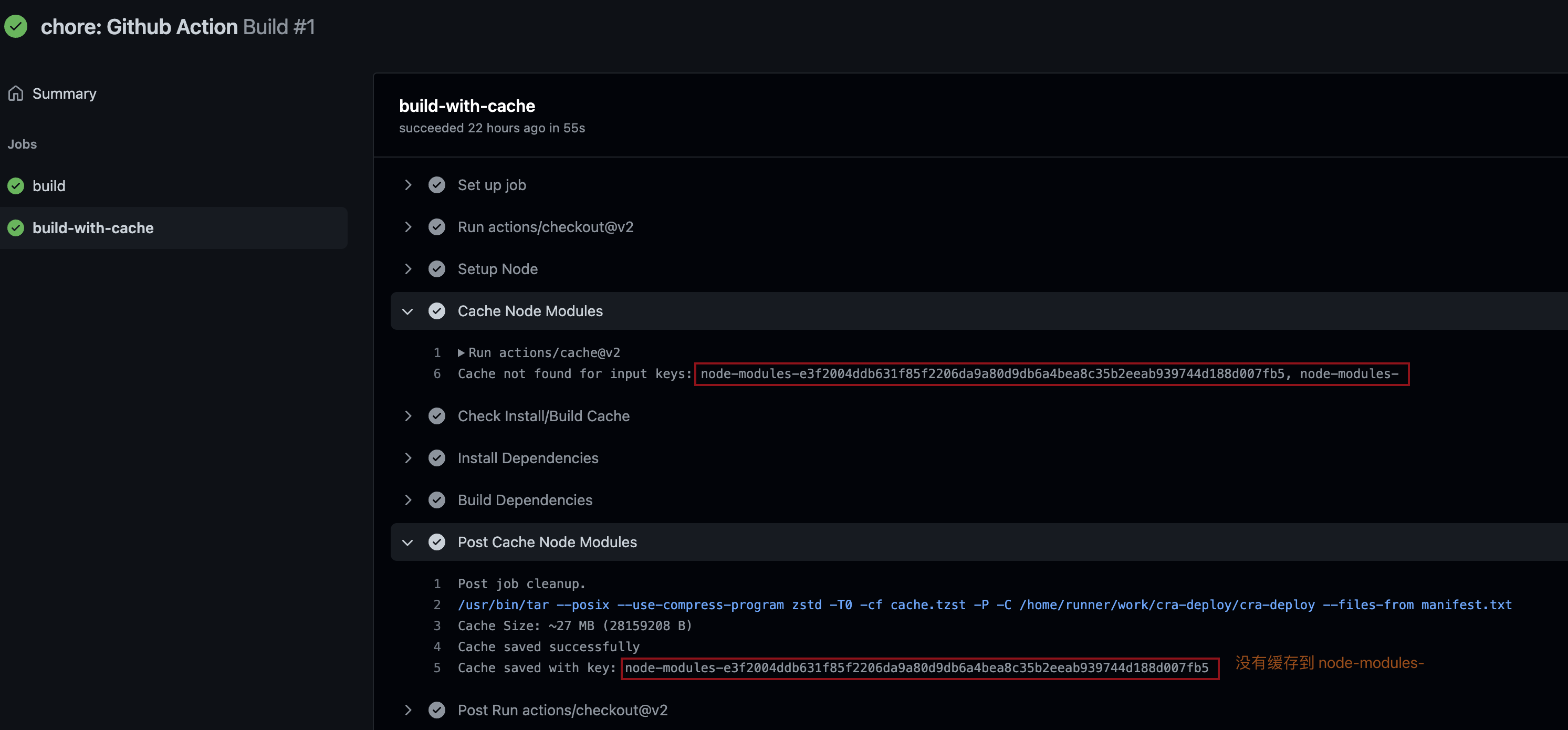 问题一:什么时候提交缓存到
问题一:什么时候提交缓存到 node-modules-,不然里面一直是空的,也没什么作用。随后我更新了依赖,且在本地 yarn 完,将
package.json和yarn.lock提交触发了第二次 CI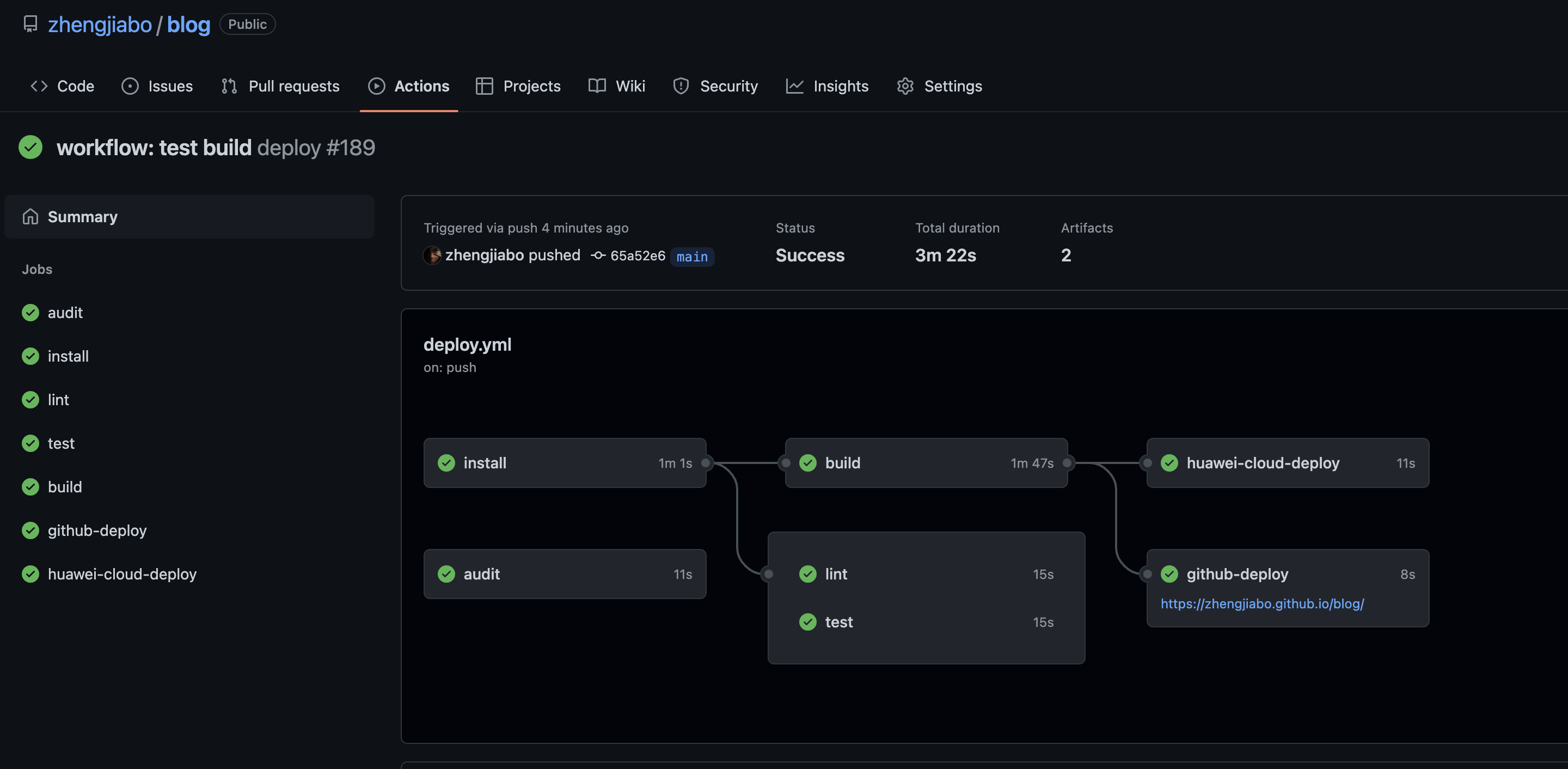 问题二:不理解以上过程 不理解为什么
问题二:不理解以上过程 不理解为什么 yarn.lock上传新的后,读取的时候 hash 还是旧的
且读取成功,命中输出也是false,进而执行了依赖安装
最后缓存的时候 hash 变成新的[ ] 压缩时间过长,有办法优化吗?
由于担心缓存 node_modules 会出问题,所以跟着官方例子只缓存了全局,每次都读取全局缓存后执行yarn安装依赖。安装完需要将node_modules压缩上传供其他 job 调用,但压缩时间也挺长的,比安装依赖还长感觉有点得不偿失,还不如每个 job 都单独去安装依赖yaml# 安装依赖 不推荐直接缓存 node_modules,自己的项目可以,但企业内依赖变动可能多,缓存 node_modules 有时候会出现问题,但可以缓存 yarn 全局依赖。后续使用 pnpm 安装可能速度更快 - name: Install Dependencies # if: steps.cache-node-modules.outputs.cache-hit != 'true' run: yarn # 压缩(归档)依赖 https://www.gnu.org/software/tar/ - name: Archive Artifact shell: bash run: | # $RUNNER_TEMP 临时运行路径,本次任务执行完消除 # --dereference 提取符号链接属性,如上次修改的时间和链接权限 –-hard-dereference 取消对硬链接的引用并存储它们所引用的文件,而不是创建通常的硬链接 # -j bzip2 格式 压缩率高 tar \ -jcvf "node_modules.bz2" \ node_modules # 上传依赖,由于 node_modules 不用缓存,此处上传资源供其他 job 读取 - name: Upload a Node Modules Artifact uses: actions/upload-artifact@v3.1.0 with: name: node-modules path: node_modules.bz2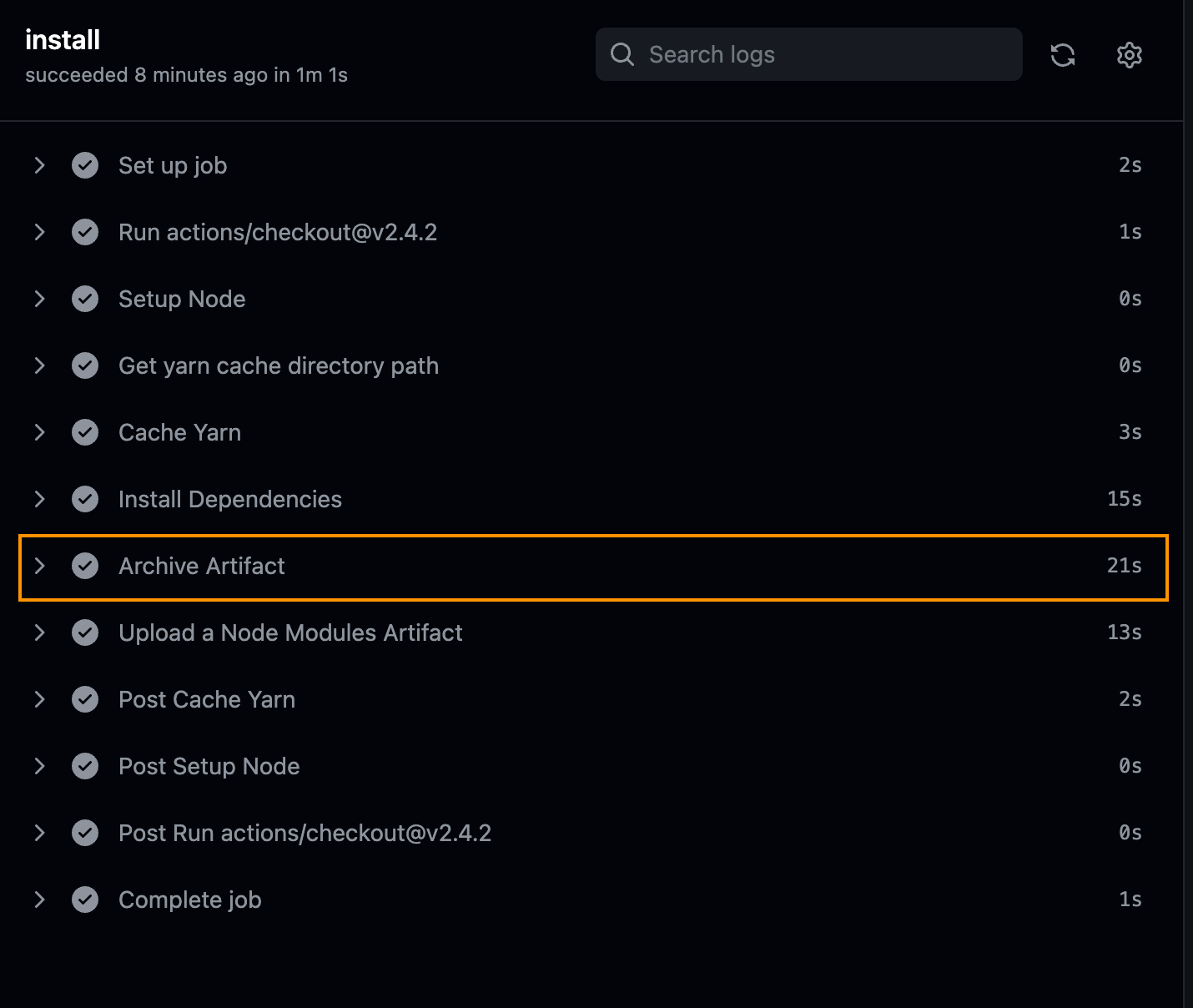
1. 前提提要、场景
在本地环境中,安装依赖时都会利用缓存,例如
- 当使用
npm i进行依赖安装时,由于 node_modules 目录已存在,将只会安装最新添加的依赖。 - 当使用 webpack 5 进行构建时,如果使用了
filesystem cache,因为在磁盘中含有缓存node_modules/.cache,二次构建往往比一次构建快速十几倍。
而在 CI/CD 中,这些都失去了意义,因为 CI/CD 每次 Job 都相当于新建了一个目录,每次构建都相当于是首次构建。但是,CI 提供了一些缓存机制,可以将一些资源进行缓存。如果每次可以将缓存取出来,则大大加速了前端部署的速度。

- 安装依赖-使用缓存
- 打包缓存
- 容器资源挂载
利用缓存的目的:减少 CI/CD 时间。
2. 无缓存安装依赖/打包
如果不进行任何缓存上的优化,对应 Github Actions
name: Build
on: [push]
jobs:
build:
runs-on: ubuntu-latest
steps:
- uses: actions/checkout@v2
- name: Setup Node
uses: actions/setup-node@v1
with:
node-version: 14.x
- name: Install Dependencies
run: yarn
- name: Build Dependencies
run: npm run build
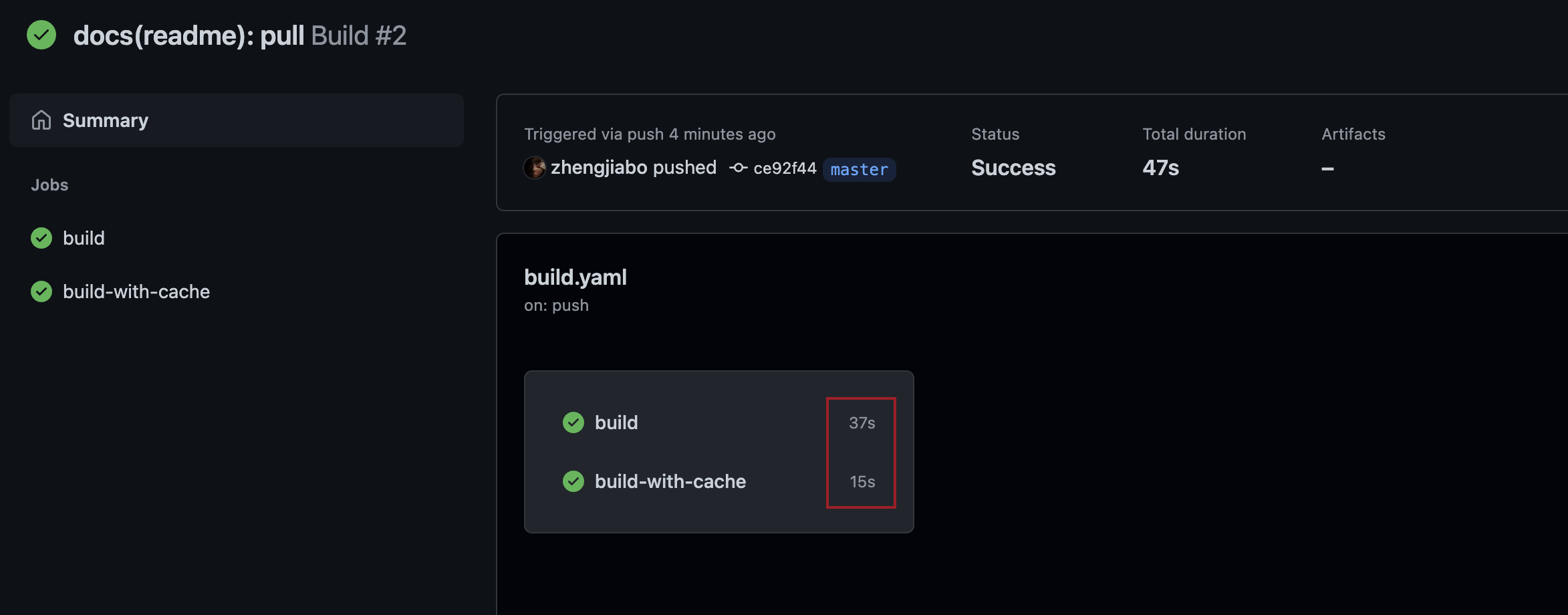 可以看到无缓存安装依赖/打包的时间,要比有缓存长很多。
可以看到无缓存安装依赖/打包的时间,要比有缓存长很多。
第一次执行可能有缓存的会比无缓存耗时长,因为第一次都是无缓存资源,而有缓存的 job 还要去尝试获取缓存,获取也需要时间。
3. 缓存配置
对 node_modules 进行缓存有以下两个好处
- 没有新的 package 需要安装,无需再次
npm i/yarn - 有新的 package 需要安装,仅仅安装变动的 package
在 Github Actions 中,通过 Cache Action
- path:指需要缓存的目录
- key:根据 key 进行缓存,如果存在相同的 key,则为命中 (hit)。在
Github Actions中可利用函数hashFiles针对文件计算其 hash 值。 - restore-keys:如果 ke 未命中,则尝试使用 restore-keys 命中缓存。
输出
- cache-hit:是否命中缓存,布尔值
3.1 缓存依赖
- name: Cache Node Modules
id: cache-node-modules
# 使用 cache action 进行目录资源缓存
uses: actions/cache@v2
with:
# 对 node_modules 目录进行缓存
path: node_modules
# 根据字段 node-modules- 与 yarn.lock 的 hash 值作为 key
# 当 yarn.lock 内容未发生更改时,key 将不会更改,则命中缓存
# 如果使用 npm 作为包管理工具,则是 package-lock.json
key: node-modules-${{ hashFiles('yarn.lock') }}
restore-keys: node-modules- # 备用字段
缓存 node_modules 有时会存在问题,比如使用 npm ci 命令,在安装依赖之前特意将 node_modules 删除以保障安全性。
如果不想缓存 node_modules,可以缓存 npm/yarn 全局缓存目录。通过以下命令可知他们的全局缓存目录
- npm:
npm config get cache,如 ~/.npm - yarn:
yarn cache dir
3.2 缓存验证
可以通过 ls -lah node_modules 查看是否有缓存目录
# 查看缓存是否设置成功,输出 node_modules 目录
- name: Check Install/Build Cache
run: ls -lah node_modules | head -5
Cache Action 提供了更有效的返回 cache-hit 表示是否命中缓存。
- name: Cache Node Modules
id: cache-node-modules
# 使用 cache action 进行目录资源缓存
uses: actions/cache@v2
with:
# 对 node_modules 目录进行缓存
path: node_modules
# 根据字段 node-modules- 与 yarn.lock 的 hash 值作为 key
# 当 yarn.lock 内容未发生更改时,key 将不会更改,则命中缓存
# 如果使用 npm 作为包管理工具,则是 package-lock.json
key: node-modules-${{ hashFiles('yarn.lock') }}
restore-keys: node-modules- # 备用字段
- name: Install Dependencies
# 如果命中 key,则直接跳过依赖安装
if: steps.cache-node-modules.outputs.cache-hit != 'true'
run: yarn
steps.cache-node-modules.outputs.cache-hit 可获得 ID 为 cache-node-modules 的命中缓存结果。条件语句,若命中,则无需再次安装依赖。即使缓存未命中,我们也可以同样利用备用字段 node-modules- 中内容(第一次执行没有),依赖安装时间也大幅降低。 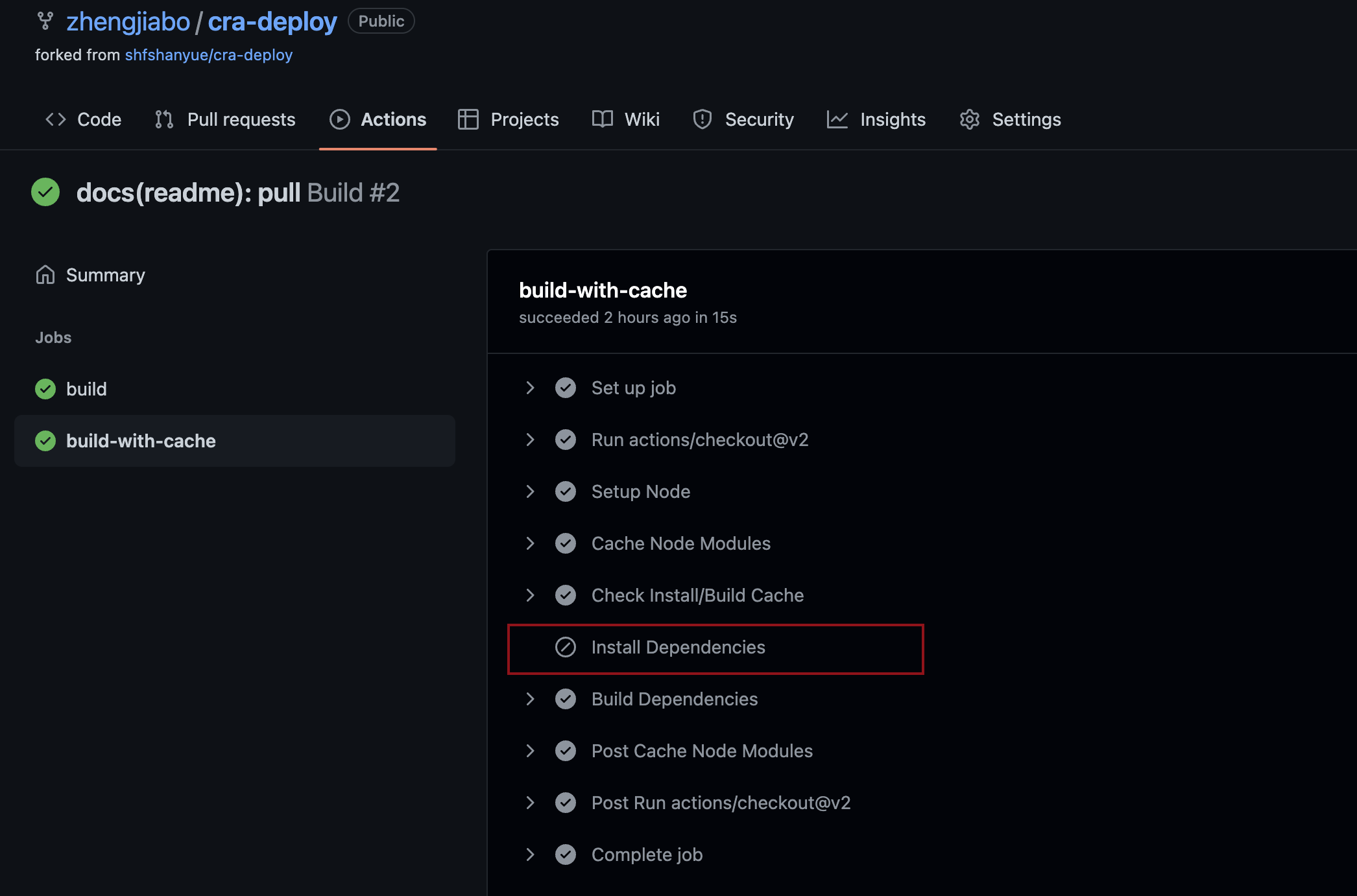
3.3 完整配置文件

name: deploy
on:
workflow_dispatch: # 允许手动触发
push:
branches: [main]
pull_request:
branches: [main]
# Sets permissions of the GITHUB_TOKEN to allow deployment to GitHub Pages
permissions:
contents: read
pages: write
id-token: write
# Allow one concurrent deployment
concurrency:
group: "pages"
cancel-in-progress: true
jobs:
# 检查依赖的安全风险
audit:
runs-on: ubuntu-latest
steps: #执行步骤
- uses: actions/checkout@v2.4.2
- name: Setup Node
uses: actions/setup-node@v3.4.1
with:
node-version: 16.x
# 执行检查-只针对打包
- name: Run a Security Audit
continue-on-error: true # 因为现在还没精力去调配依赖,报错先跳过
run: npm audit --only=prod
# 安装依赖
install:
runs-on: ubuntu-latest # 指定环境
steps: #执行步骤
# 拉取当前分支代码
- uses: actions/checkout@v2.4.2
# 安装 Node
- name: Setup Node
uses: actions/setup-node@v3.4.1
with:
node-version: 16.x
# 获得 yarn 缓存路径
- name: Get yarn cache directory path
id: yarn-cache-dir-path
run: echo "::set-output name=dir::$(yarn cache dir)"
# 读取缓存
- name: Cache Yarn
uses: actions/cache@v3
id: yarn-cache # use this to check for `cache-hit` (`steps.yarn-cache.outputs.cache-hit != 'true'`)
with:
path: ${{ steps.yarn-cache-dir-path.outputs.dir }}
key: ${{ runner.os }}-yarn-${{ hashFiles('**/yarn.lock') }}
restore-keys: |
${{ runner.os }}-yarn-
# 安装依赖 不推荐直接缓存 node_modules,自己的项目可以,但企业内依赖变动可能多,缓存 node_modules 有时候会出现问题,但可以缓存 yarn 全局依赖。后续使用 pnpm 安装可能速度更快
- name: Install Dependencies
# if: steps.cache-node-modules.outputs.cache-hit != 'true'
run: yarn
# 压缩(归档)依赖 https://www.gnu.org/software/tar/
- name: Archive Artifact
shell: bash
run: | # $RUNNER_TEMP 临时运行路径,本次任务执行完消除 # --dereference 提取符号链接属性,如上次修改的时间和链接权限 –-hard-dereference 取消对硬链接的引用并存储它们所引用的文件,而不是创建通常的硬链接 # -j bzip2 格式 压缩率高
tar \
-jcvf "node_modules.bz2" \
node_modules
# 上传依赖,由于 node_modules 不用缓存,此处上传资源供其他 job 读取
- name: Upload a Node Modules Artifact
uses: actions/upload-artifact@v3.1.0
with:
name: node-modules
path: node_modules.bz2
# 校验
lint:
runs-on: ubuntu-latest # 指定环境
needs: [install] # 前置任务
steps: #执行步骤
- uses: actions/checkout@v2.4.2
- name: Setup Node
uses: actions/setup-node@v3.4.1
with:
node-version: 16.x
# 下载 node_modules 文件
- name: Download a Node Modules Artifact
uses: actions/download-artifact@v3.0.0
with:
# 唯一标志
name: node-modules
# 下载至文件夹
path: ''
# 解压依赖
- name: Extract Artifact
shell: bash
run: | # --dereference 提取符号链接属性,如上次修改的时间和链接权限 –-hard-dereference 取消对硬链接的引用并存储它们所引用的文件,而不是创建通常的硬链接 # -j bzip2 格式 压缩率高
tar \
-jxvf "node_modules.bz2"
# 校验
- name: Eslint
run: yarn lint
# 测试用例
test:
runs-on: ubuntu-latest # 指定环境
needs: [install] # 前置任务
steps: #执行步骤
- uses: actions/checkout@v2.4.2
- name: Setup Node
uses: actions/setup-node@v3.4.1
with:
node-version: 16.x
# 下载 node_modules 文件
- name: Download a Node Modules Artifact
uses: actions/download-artifact@v3.0.0
with:
# 唯一标志
name: node-modules
# 下载至文件夹
path: ''
# 解压依赖
- name: Extract Artifact
shell: bash
run: | # --dereference 提取符号链接属性,如上次修改的时间和链接权限 –-hard-dereference 取消对硬链接的引用并存储它们所引用的文件,而不是创建通常的硬链接 # -j bzip2 格式 压缩率高
tar \
-jxvf "node_modules.bz2"
# 校验
- name: Test
run: yarn test
# 打包
build:
runs-on: ubuntu-latest # 指定环境
needs: [install] # 前置任务
steps: #执行步骤
- uses: actions/checkout@v2.4.2
- name: Setup Node
uses: actions/setup-node@v3.4.1
with:
node-version: 16.x
# 下载 node_modules 文件
- name: Download a Node Modules Artifact
uses: actions/download-artifact@v3.0.0
with:
# 唯一标志
name: node-modules
# 下载至文件夹
path: ''
# 解压依赖
- name: Extract Artifact
shell: bash
run: | # --dereference 提取符号链接属性,如上次修改的时间和链接权限 –-hard-dereference 取消对硬链接的引用并存储它们所引用的文件,而不是创建通常的硬链接 # -j bzip2 格式 压缩率高
tar \
-jxvf "node_modules.bz2"
# 打包
- name: Build Dependencies
run: yarn build
# 上传用于 Github Page 发布
- name: Upload Artifact
uses: actions/upload-pages-artifact@v1
with:
path: public/blog/
# 发布到github page
github-deploy:
needs: [build]
environment:
name: github-pages
url: ${{ steps.deployment.outputs.page_url }}
runs-on: ubuntu-latest
steps:
- name: Deploy to GitHub Pages
id: deployment
uses: actions/deploy-pages@v1
# 发布到华为云服务器
huawei-cloud-deploy:
# 前提打包完成
needs: [build]
runs-on: ubuntu-latest
steps:
# 下载打包后文件
- name: Download a Build Artifact
uses: actions/download-artifact@v3.0.0
with:
# 唯一标志
name: github-pages # actions/upload-pages-artifact 是利用 upload-artifact 上传到 github-pages 标志,文件名为 artifact.tar
# 下载至文件夹
path: ''
# 此时还是压缩包,可以上传后解压
- name: Check Build
run: ls -lah
# 可以使用 rsync,但还是不推荐直连,后续改掉
- name: send files to a remote server with scp
uses: appleboy/scp-action@master
continue-on-error: true
with:
host: ${{ secrets.HUAWEI_IP }}
username: ${{ secrets.HUAWEI_USER_NAME }}
password: ${{ secrets.HUAWEI_ACCESS_KEY_SECRET }}
source: './*'
target: ../var/www/blog
# 失败重试 3 次
retry-attempts: 3